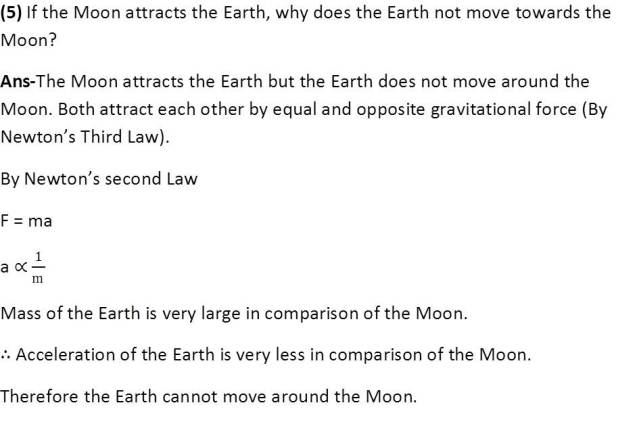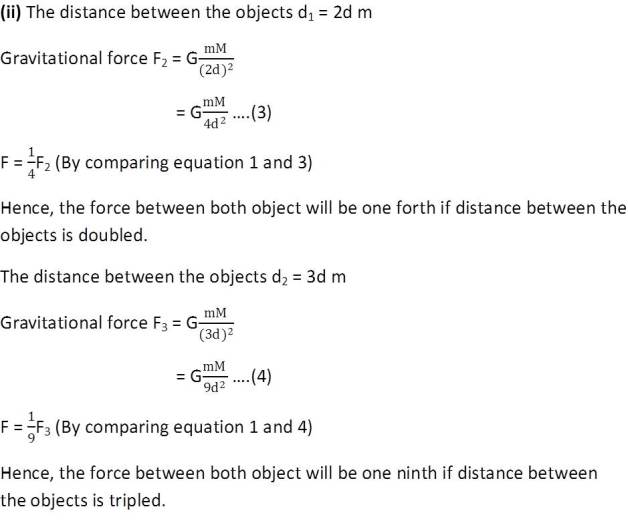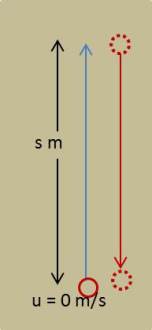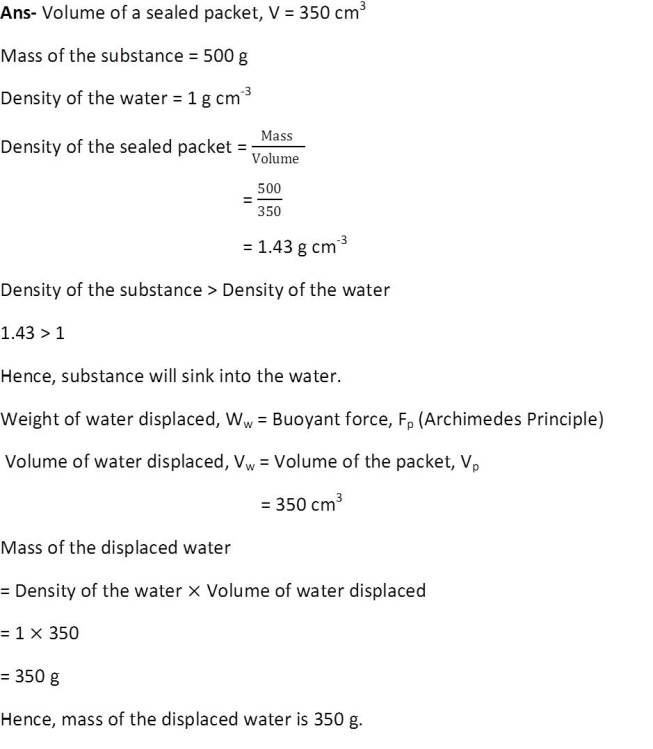
 Page no 136
Page no 136
(1) What do you mean by the free fall?
Ans- When an object fall towards earth only due to gravitational force with no air resistance is called free fall.
(2) What do you mean by acceleration due to gravity?
Ans- Acceleration is caused due to change in the velocity. When a body falls from a height towards the earth, the magnitude of the velocity of the body changes due to air resistance which causes acceleration. This acceleration is known as acceleration due to gravity.
It is denoted by ‘g’ and its value is 9.8 m/s2.
Page 138
(1) What are the differences between the mass of an object and its weight?
Ans- The differences between the mas and the weight are tabulated below –
| SN | Mass | Weight |
| 1 | Constant everywhere | Can be change |
| 2 | Can not change if value of g changes on different planets or anywhere | Can change according to acceleration on different places planets or anywhere. |
| 3 | Mass is not equal to force of attraction of the earth on an object | Weight is equal to force of attraction of the earth on an object |
| 4 | It is a measure of inertia. | It is a measure of gravity. |
| 5 | Its unit is kg. | Its unit is Newton. |
 (2) What do you mean by buoyancy?
(2) What do you mean by buoyancy?
Ans- Buoyancy is an upward force exerted by the fluid in which a body immersed. It is also called as upthrust or buoyant force.
The magnitude of this buoyant force depends on the density of the fluid.
The SI unit of buoyancy is newton.
(3) Why does an object float or sink when placed on the surface of water?
Ans- An object sinks in water if
(a) If downward force is greater than the upward force, the nail sinks.
(b) The density of the object is very high in comparison of the density of the water. Therefore, the upthrust force or buoyant force of water on the object is less than the weight of the object. Hence, it sinks.
An objects float in the water or liquid if
(a) The downward force is less than the upward force, the cork floats.
(b) The density of the object is lesser than the density of the water. Therefore, the upthrust force or buoyant force of water on the object is higher than the weight of the object. Hence, it floats.
Page no 142
(1) You find your mass to be 42 kg on a weighing machine. Is your mass more or less than 42 kg?
Ans – My mass will be less than 42 kg of weight.
Because
Weight = Mass g
Therefore, weight is greater than the mass of the object.
(2) You have a bag of cotton and an iron bar, each indicating a mass of 200 kg when measured on a weighing machine. In reality, one is heavier than other. Can you say which one is heavier and why?
Ans – The cotton bag and iron bar both have same mass 200 kg.
If area is large, upthrust fore is high …Condition 1
If area is low, upthrust force is low … Condition 2
The area of cotton bag has large area because of less density of the cotton. Therefore, upthrust force on the cotton bag is high. Hence, cotton bag feels less heavy (condition 1).
The area of iron bag has less area because of high density of the iron. Therefore, upthrust force on the iron bag is low. Hence, iron bag feels heavy (condition 2).
Therefore, Iron bar bag is heavier than cotton bag.








(7) What is the importance of universal law of gravitation?
Ans- The importance of the universal law of gravitation are –
(i) the force that bind us to the Earth.
(ii) the motion of the moon around the Earth.
(iii) the motion of the planets around the Sun.
(iv) the tides due to the moon and the Sun.
(8) What is the acceleration of the free fall?
Ans- Acceleration of free fall of any object is acceleration due to change in magnitude of the velocity (Direction of object is always downward for free fall object) of falling object. The acceleration of the free fall is equal to earth’s gravity, ie, 9.8 m/s2.
(9) What do we call the gravitational force between the earth and an object?
Ans – The gravitational force between the earth and an object is known as gravity of earth or weight of the object.
(10) Amit buys few grams of gold at the poles as per the instruction of one of his friends. He hands over the same when he meets him at equator. Will the friend agree with the weight of gold bought? If not, Why? [Hint: The value of g is greater at the poles than at the equator.]
Ans- No, friend of Amit will not be agree with the weight of gold bought at the poles.
Because,
Weight = Mass × Acceleration
Acceleration at poles > acceleration at the equator
Weight of the gold at poles > Weight of the gold at the equator
Therefore, friend of Amit will feel less weight of gold in comparison of weight of the gold at poles.
(11) Why will a sheet of paper fall slower than one that is crumpled into a ball?
Ans- A sheet of paper fall slower than one that is crumpled into a ball because of air resistance. The air resists the motion of the sheet and the crumpled ball due to inertia. But resistance offered on the sheet is higher than the crumpled ball. Therefore, a sheet of paper will fall slower than one that is crumpled into a ball.




(15) A stone is thrown vertically upward with an initial velocity of 40 m/s. Taking g = 10 m/s2, find the maximum height reached by the stone. What is the net displacement and the total distance covered by the stone.
Ans-



(17) A stone is allowed to fall from the top of a tower 100 m high and at the same time another stone is projected vertically upwards from the ground with a velocity of 25 m/s. Calculate when and where the two stones will meet.
Ans-



(18) A ball thrown up vertically returns to the thrower after 6 s. Find
(a) the velocity with which it was thrown up,
(b) the maximum height it reaches , and
(c) its position after 4 s.
Ans- Let a ball was thrown from point A. It reaches to point B and come back to point A.
Time taken by ball from A to B and B to A = 6 s
(a) Let velocity of the ball with which it was thrown up = u m/s (Initial velocity)
Final velocity, v = 0 m/s
Time, t = 6 sec
a = g = – 9.8 m/s2 (Upward direction)
v = u + at
0 = u + (- 9.8)6
u = 58.8 m/s
Hence, the ball is thrown at the speed of 58.8 m/s in upward direction.
(b) Let the maximum height reaches by the ball = s m
Initial velocity of the ball, u = 58.8 m/s
a = g = – 9.8 m/s2 (Upward direction)
Final velocity, v = 0 m/s
v2 = u2 + 2as
0 = 58.82 + 2(-9.8)s


(19) In what direction does the buoyant force on an object immersed in a liquid act?
Ans – The buoyant force on an object immersed in a liquid acts upward on the object.
(20) Why does a block of plastic released under water come up to surface of water?
Ans – A block of plastic released under water come up to surface of water because –
(i) Buoyant force is greater than the weight of the plastic block.
(ii) The density of the plastic block is greater than the density of the water.
 (22) The volume of a 500 g sealed packet is 350 cm3. Will the packet float or sink in water if the density of water is 1 g cm-3? What will be the mass of the water displaced by this packet?
(22) The volume of a 500 g sealed packet is 350 cm3. Will the packet float or sink in water if the density of water is 1 g cm-3? What will be the mass of the water displaced by this packet?

Helping Topics
